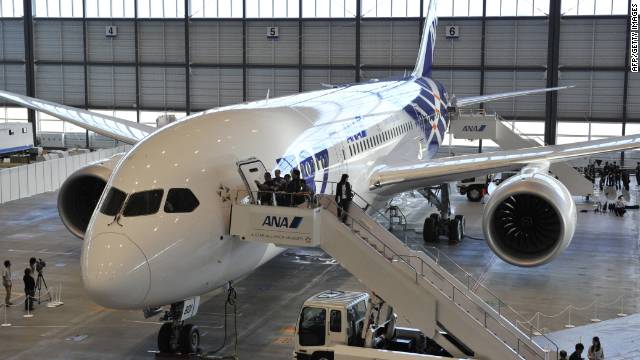
The much anticipated 787 Dreamliner is here and the first maiden passenger voyage is slated for tomorrow (Wed., Oct., 26, 2011) by Japan`s All Nippon Airways, carrying 250 passengers from Tokyo to Hong Kong.
Considered the most advanced sophisticated piece of avionics to fly the open skies from Boeing, it was built with a "visionary design" to rival competitors in the aviation industry.
11:59 AM EST, Tue October 25, 2011

The first All Nippon Airways (ANA) Boeing 787 Dreamliner is displayed during a press preview at Tokyo's Haneda airport on September 28.
(image CNN)
Hong Kong (CNN) -- Boeing's 787 Dreamliner makes its first passenger flight Wednesday, carrying about 250 passengers from Tokyo to Hong Kong on Japan's All Nippon Airways. Boeing has spent years and billions of dollars developing a plane with what it calls "visionary design." As the first customers prepare to fly on the Dreamliner, CNN looks at what sets the 787 apart from the planes before it.
Hong Kong (CNN) -- Boeing's 787 Dreamliner makes its first passenger flight Wednesday, carrying about 250 passengers from Tokyo to Hong Kong on Japan's All Nippon Airways. Boeing has spent years and billions of dollars developing a plane with what it calls "visionary design." As the first customers prepare to fly on the Dreamliner, CNN looks at what sets the 787 apart from the planes before it.
1. It's Plastic (sort of)
The Dreamliner is made of 50% composite materials, carbon-fiber enforced polymers that are both lighter and more durable than traditional aluminum. Composite materials have been used before in passenger planes but never to this extent. They comprise both the wings and the fuselage of the 787. Most of the features listed below could not have been built in an airplane made mostly of traditional aluminum.
The Dreamliner is made of 50% composite materials, carbon-fiber enforced polymers that are both lighter and more durable than traditional aluminum. Composite materials have been used before in passenger planes but never to this extent. They comprise both the wings and the fuselage of the 787. Most of the features listed below could not have been built in an airplane made mostly of traditional aluminum.
2. The Air Inside
The cabin pressure on the 787 is higher and the humidity higher than other airplanes. Basically, passengers on board will feel like they are at an altitude of 6,000 feet, 2,000 feet lower than a standard flight. The changes will cut down on passenger fatigue, dry eyes and headaches, Boeing said. They are made possible by the new material, which is less prone to corrosion and structural fatigue than traditional aluminum.
The cabin pressure on the 787 is higher and the humidity higher than other airplanes. Basically, passengers on board will feel like they are at an altitude of 6,000 feet, 2,000 feet lower than a standard flight. The changes will cut down on passenger fatigue, dry eyes and headaches, Boeing said. They are made possible by the new material, which is less prone to corrosion and structural fatigue than traditional aluminum.
3. More Space
Boeing's Chief Pilot Randy Neville said he believed this is the first feature passengers will notice about the new plane. You are "not being squeezed into a tube," he said. "You'll have a wide open area." There is also more room for overhead luggage.
Boeing's Chief Pilot Randy Neville said he believed this is the first feature passengers will notice about the new plane. You are "not being squeezed into a tube," he said. "You'll have a wide open area." There is also more room for overhead luggage.
4. Fuel Efficiency
The 787 is 20% more fuel efficient than similarly-sized aircraft, a change which allows airlines to save money and deploy the plane on longer routes, Boeing said. "On an aircraft of that size, even a slight reduction in fuel burn makes a big difference to overall cost," said Paul Sheridan, Head of Risk Advisory at Ascend. Another plus, according to aviation experts, the longer range will allow carriers to introduce more point-to-point routes, so passengers will have more options and fewer layovers.
The 787 is 20% more fuel efficient than similarly-sized aircraft, a change which allows airlines to save money and deploy the plane on longer routes, Boeing said. "On an aircraft of that size, even a slight reduction in fuel burn makes a big difference to overall cost," said Paul Sheridan, Head of Risk Advisory at Ascend. Another plus, according to aviation experts, the longer range will allow carriers to introduce more point-to-point routes, so passengers will have more options and fewer layovers.
5. Intuitive Cockpit
Neville feels Boeing has worked hard to make operating the 787 as natural as possible for pilots. "The flight deck is laid out so it is very intuitive to operate all the controls," he said. One example: The Head-Up Display (HUD) used by pilots is displayed on glass, so they can see the data without having to lose sight of what's going on outside.
Neville feels Boeing has worked hard to make operating the 787 as natural as possible for pilots. "The flight deck is laid out so it is very intuitive to operate all the controls," he said. One example: The Head-Up Display (HUD) used by pilots is displayed on glass, so they can see the data without having to lose sight of what's going on outside.
6. Bigger Windows
Clearly a case where bigger is bigger, the Dreamliner has windows that are 19 inches tall and 30% bigger than the on similarly-sized aircraft. Say goodbye to those plastic shades as well. The Dreamliner is the first commercial plane to have electronic dimmers at each seat. The flight attendants can also darken or lighten all the shades automatically, so never again will a small child wake up half the plane by deciding to let in a little sunlight.
Clearly a case where bigger is bigger, the Dreamliner has windows that are 19 inches tall and 30% bigger than the on similarly-sized aircraft. Say goodbye to those plastic shades as well. The Dreamliner is the first commercial plane to have electronic dimmers at each seat. The flight attendants can also darken or lighten all the shades automatically, so never again will a small child wake up half the plane by deciding to let in a little sunlight.
7. Uniformity
Don't expect much difference from one Dreamliner to the next, Sheridan said. Boeing purposely limited the extent that carriers could customize the new plane in order to appeal to banks and leasing companies that are behind many purchases. If all the planes are similar, it's easier to hire them out to airlines or resell if needed.
Don't expect much difference from one Dreamliner to the next, Sheridan said. Boeing purposely limited the extent that carriers could customize the new plane in order to appeal to banks and leasing companies that are behind many purchases. If all the planes are similar, it's easier to hire them out to airlines or resell if needed.




















































































































No comments:
Post a Comment